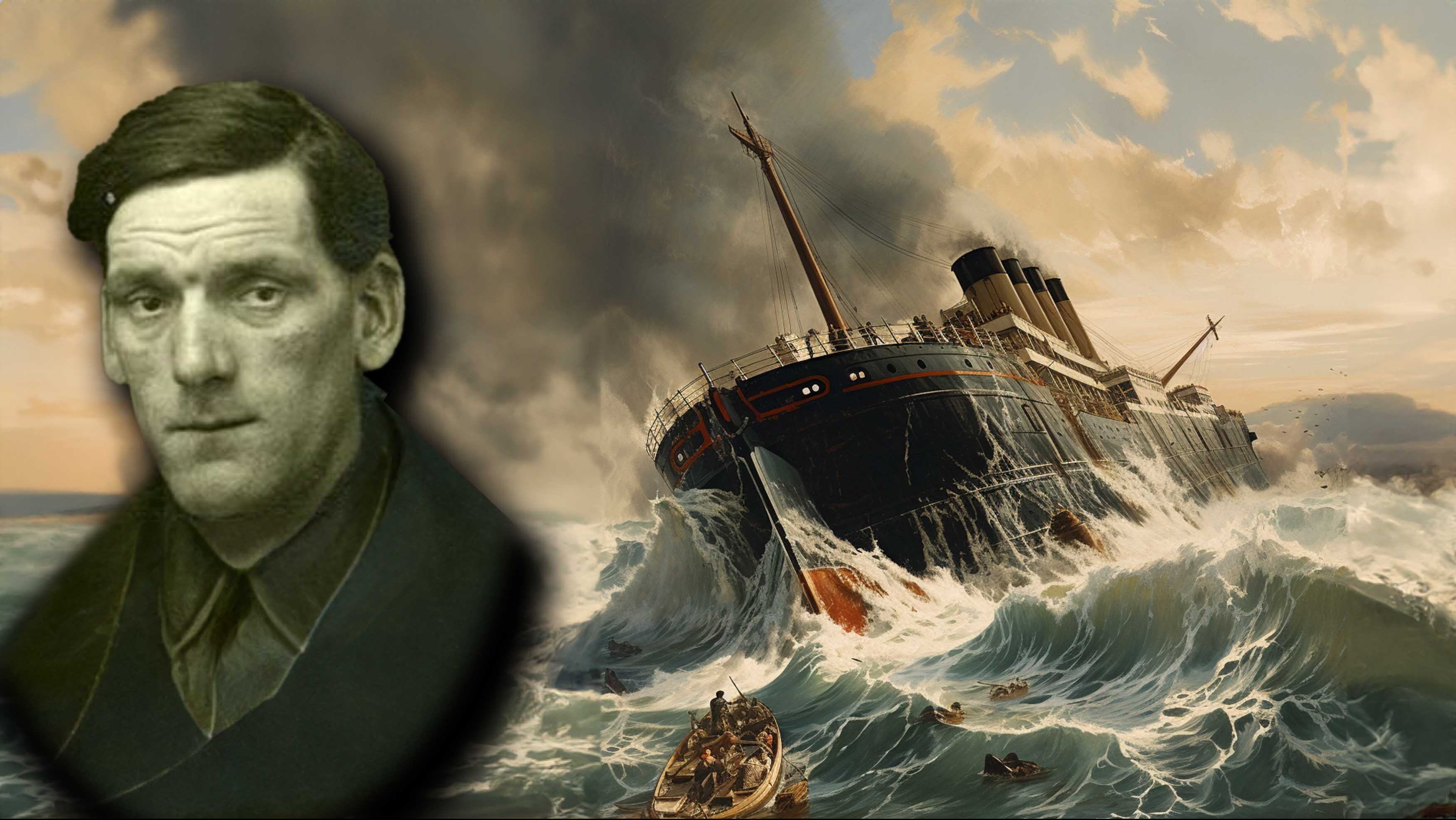Unsinkable: The Man Who Wouldn’t Die
Imagine living through one disaster at sea, only to suffer another disaster months later, then again…and again, again and again. Arthur John Priest survived as many as 4 sinking ships and 6 total sea disasters in his short career as a coal stoker. His tale is one of luck. Whether you choose to see it as bad luck or good luck depends on your point of view. But this is an amazing story either way. In this episode, we learn about Arthur John Priest, Sam the Unsinkable Cat, and then play the quick quiz with Magician, Erik Tait!

Imagine loving the sea, spending your whole life sailing and then, once you retire – not being able to talk anyone into sailing with you. That was the fate of Arthur John Priest.
Before we talk about Arthur John Priest, I want to talk about an unrelated cat. I know, that was a sharp turn. But this wasn’t just any cat. This was a lucky cat during World War Two. He was known as Sam, but others called him Oscar. During World War Two, Sam the cat was on board the German Battleship Bismarck. The Bismarck saw a famous and fierce naval battle in May of 1941 when she was sank by British Ships in the Battle of the Denmark Strait and the pursuit that followed after. The Bismarck had over 2,100 German sailors on board and only 115 survived. But along with those 115, floating on the wreckage of the ship, was Sam the cat.
Sam, along with other survivors, were picked up by the British Destroyer HMS Cossack and named Oscar. Oscar for the letter O, which in the naval International Code of Signals, stood for “Man Overboard.” Only 5 months later, that ship too, was sunk when a German U-boat’s torpedo ripped into her bow, killing 159 sailors. The cat lived through this attack as well and was rescued.
Sometime between October and November, the cat was renamed “Sam” and often called “Unsinkable Sam.” One of the ships that was in the battle that sank the Bismarck was the aircraft carrier, HMS Ark Royal. Sam was put onboard the Ark Royal as their ship mascot. But that November, it encountered U-81, another German U boat and was hit with a torpedo. This time, most of the crew was saved, as the carrier slowly rolled over before sinking – along with those saved, once again, was Sam the cat.
So one cat survived 3 sinking ships in just 6 months. And believe it or not, our story about Arthur John Priest is more amazing than that. He survived FIVE sinking ships.
The Titanic had 29 boilers. It took a lot of men to keep those boilers steaming as the giant ship left Southhampton on April 10, 1912. 150 men to be exact. They were known as stokers, but other common slang terms for them at the time were the “Black gang” or “firemen.” It was hard work. The conditions in the bowels of the ship were hot, dirty and the hours were long. The men would often strip down and remove their shirts while working just to stay cool. Arthur John Priest, known to his friends as Jack, had worked as a stoker his whole life. On the Titanic, the black gang shoveled as much as 600 tons of coal a day to keep the ship moving.
We know most of the rest of the story. 4 days later, while off the coast of Nova Scotia, the ship struck an iceberg in the middle of the night. And of the 2,224 people on board, only 705 were rescued. Of those 705, 44 of them were stokers. That means more than 100 of the stokers working the ships boilers perished in the accident. Miraculously, Arthur John Priest was one of the 44 members of the black gang to make it out alive. He suffered some frostbite and an injured leg from swimming in the cold Atlantic water, but made his way to an already-full lifeboat, who took him aboard. It was miraculous that anyone survived the sinking of the ship with the conditions and the speed that the Titanic sank, but for a boiler room stoker, the journey in the complete pitch black bowels of the ship was a difficult one. He had to find his way from below deck through winding hallways and staircases, through gates and doors before he finally made it out. And there’s also the miraculous fact that this wasn’t his first disaster at sea.
The Titanic’s sister ship, the Olympic almost suffered a similar fate just 6 months before the Titanic’s maiden voyage. The Olympic was almost identical to the Titanic, and had a complement of the same amount of stokers working the boilers of the ship, Arthur John Priest, being one of them. On November 20th, 1911, the Olympic was sailing near the Isle of Wight, having just left Southhampton when she turned into right into a nearby British Cruiser, the HMS Hawke. The Hawke was a military ship designed to withstand ramming enemy ships. She tore two holes in the Olympic, above and below the water, flooding two of her watertight compartments and damaging a propeller. Though both ships were badly damaged, both survived and were able to make it back to Southhampton, both with gaping holes in their hulls. Jack Priest, along with everyone else on board, had escaped death.
So by the time he made it to shore in Halifax Nova Scotia after surviving a freezing cold ocean and the sinking of the Titanic, 24 year old Priest was now considering himself lucky for surviving, but perhaps unlucky for being in both of these disasters at sea – all for a salary of only 6 pounds a month. In my opinion, he was lucky. Oh – and also, the crash of the Olympic wasn’t his first time being in a disaster at sea.
Several years earlier, at the age of 20, Priest had been hired as a stoker on the RMS Asturias. It was the maiden voyage for the Royal Mail ship and it suffered a disastrous collision with another ship. While it was badly damaged, the ship returned safely and reported no serious injuries.
After recovering from his Titanic injuries, Priest enjoyed a few years of work as a fireman on ships before war broke out in Europe. The RMS Alcantra was a merchant cruiser requisitioned by the Royal British Navy and this became the HMS Alcantra just in time for the first World War. Arthur John Priest found himself hired as a fireman on board and thus joined the war effort along with many of his fellow countrymen. In February of 1916, she was fired upon by a Norwegian Merchant ship. But Michael, you may be saying – Norway was a neutral country during the war – why did they fire on a British ship? Well they didn’t. It turned out it was the German Navy Merchant Raider – a ship called Greif, who had been disguised as a Norwegian civilian ship. The two ships exchanged fire in a horrible battle at sea that left the Alcantra so badly damaged, several of her lifeboats were ruined as she listed, capsized and sank. The Greif sank as well and many sailors on both sides were killed. For Priest, 70 of his shipmates were lost. He somehow survived with no injuries except a few wounds from shrapnel.
He wasn’t giving up his job as a stoker, however. His next assignment would be on The Britannic, his third White Star Line ship after the Olympic and the Titanic. It was only 8 months after the sinking of the Alcantra and he found himself on the HMHS Brittanic, which was acting as a hospital ship bringing injured British soldiers home to Britain from the Mediterranean Sea. As it was sailing Southeast of Greece, the ship struck a mine and started sinking. She sank slowly enough for most of the crew to escape to lifeboats, although 2 of those lifeboats were sucked into the propellers, killing 30 men. Once again, Priest came out alive.
The next April, this was 1917, Arthur was working as a Stoker on another hospital ship, the SS Donegal. It was engaged by a German U-Boat but managed to outrun the enemy submarine. But then it encountered more U-Boats and was torpedoed by one of them, U-27, while in the English Channel. The ship was lost with 12 dead and more than 20 injured. Priest escaped unharmed. The Donegal still rests at the bottom of the English Channel in about 150 feet of water.
After this, Arthur John Priest decided his sailing days were over. Besides, the story had gotten out about his horrible luck with ships and no one wanted to put him in service on their crafts. In 1917, He was awarded the Mercantile Marine Ribbon for his service in the war and retired with his wife Annie in Southhampton. It was there that he lived out the rest of his days and died from Pneumonia in 1937 at the age of 49.
Newspapers around the world gave a nickname to Arthur John Priest, who survived as many as 6 accidents at sea and 4 sinking ships. He became known forever as “The Unsinkable Stoker.” The Internet Says it’s True.

Review this podcast at https://podcasts.apple.com/us/podcast/the-internet-says-it-s-true/id1530853589
Bonus episodes and content available at http://Patreon.com/MichaelKent
For special discounts and links to our sponsors, visit http://theinternetsaysitstrue.com/deals

